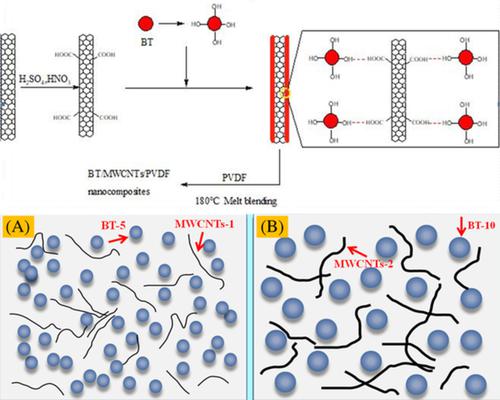当前位置:
X-MOL 学术
›
Polym. Compos.
›
论文详情
Our official English website, www.x-mol.net, welcomes your
feedback! (Note: you will need to create a separate account there.)
Mechanical, thermal, and dielectric properties of polyvinylidene fluoride nanocomposites fabricated by introducing functional MWCNTs/barium titanate compounding dielectric nanofillers
Polymer Composites ( IF 4.8 ) Pub Date : 2020-12-14 , DOI: 10.1002/pc.25908 Lin Chen 1 , Jiao Huang 1 , Lei Yan 1 , Hai Lan Lin 1 , Yi Guo 1 , Zhao Xin Zhang 1 , Xun Tao Zhang 1 , Jun Bian 1
Polymer Composites ( IF 4.8 ) Pub Date : 2020-12-14 , DOI: 10.1002/pc.25908 Lin Chen 1 , Jiao Huang 1 , Lei Yan 1 , Hai Lan Lin 1 , Yi Guo 1 , Zhao Xin Zhang 1 , Xun Tao Zhang 1 , Jun Bian 1
Affiliation

|
A facile strategy through incorporating barium titanate (BT)/multiwalled carbon nanotubes (MWCNTs) compounding dielectric nanofillers into polyvinylidene fluoride (PVDF) via melt‐processing was proposed. Benefiting from the strong interfacial interactions between BT and MWCNTs, as well as oxygen‐containing groups of BT/MWCNTs and fluorine atoms of PVDF, the sandwiched structure was constructed and thus tailoring the microstructure and enhancing the mechanical, thermal and dielectric properties of resultant nanocomposites. The effects of BT/MWCNTs multiscale dielectric nanofiller on the mechanical properties, heat resistance and dielectric properties of nanocomposites were investigated by infrared spectra, X‐ray diffraction (XRD), differential scanning calorimetry (DSC) analysis, field emission scanning electron microscope, tensile and dielectric tests. XRD and DSC analysis indicated that compared with neat PVDF, BT/PVDF and MWCNTs/PVDF nanocomposites, the BT/MWCNTs/PVDF nanocomposites showed higher crystallinity and thermal properties. The dielectric performance tests showed that the BT/MWCNTs/PVDF nanocomposites had better dielectric performance than those of BT/PVDF and MWCNTs/PVDF nanocomposites. At 100 Hz, the dielectric constant of BT/MWCNTs/PVDF nanocomposites reached 119, which was 14 times that of neat PVDF, and the dielectric loss was only 0.051. The BT/MWCNTs/PVDF nanocomposites showed the tensile strength of 57.7 MPa and the tensile modulus of 1226 MPa, respectively. This work provides a novel strategy for the fabrication of PVDF based dielectric nanocomposites, inspiring the research and development of PVDF in the energy‐related areas in the future.
中文翻译:

通过引入功能性MWCNT /钛酸钡复合介电纳米填料制备的聚偏二氟乙烯纳米复合材料的机械,热和介电性能
提出了一种通过熔融加工将钛酸钡(BT)/多壁碳纳米管(MWCNTs)和电介质纳米填料复合到聚偏二氟乙烯(PVDF)中的简便策略。得益于BT和MWCNT之间的强界面相互作用以及BT / MWCNT的含氧基团和PVDF的氟原子,构造了三明治结构,从而调整了微结构并增强了所得纳米复合材料的机械,热和介电性能。通过红外光谱,X射线衍射(XRD),差示扫描量热法(DSC)分析,场发射扫描电子显微镜,研究了BT / MWCNTs多尺度介电纳米填料对纳米复合材料力学性能,耐热性和介电性能的影响。拉伸和介电测试。XRD和DSC分析表明,与纯PVDF,BT / PVDF和MWCNTs / PVDF纳米复合材料相比,BT / MWCNTs / PVDF纳米复合材料具有更高的结晶度和热性能。介电性能测试表明,BT / MWCNTs / PVDF纳米复合材料具有比BT / PVDF和MWCNTs / PVDF纳米复合材料更好的介电性能。在100 Hz时,BT / MWCNTs / PVDF纳米复合材料的介电常数达到119,是纯PVDF的14倍,介电损耗仅为0.051。BT / MWCNTs / PVDF纳米复合材料的拉伸强度分别为57.7 MPa和1226 MPa。这项工作为基于PVDF的介电纳米复合材料的制造提供了一种新颖的策略,激发了PVDF在未来能源相关领域的研究和开发。XRD和DSC分析表明,与纯PVDF,BT / PVDF和MWCNTs / PVDF纳米复合材料相比,BT / MWCNTs / PVDF纳米复合材料具有更高的结晶度和热性能。介电性能测试表明,BT / MWCNTs / PVDF纳米复合材料具有比BT / PVDF和MWCNTs / PVDF纳米复合材料更好的介电性能。在100 Hz时,BT / MWCNTs / PVDF纳米复合材料的介电常数达到119,是纯PVDF的14倍,介电损耗仅为0.051。BT / MWCNTs / PVDF纳米复合材料的拉伸强度分别为57.7 MPa和1226 MPa。这项工作为基于PVDF的介电纳米复合材料的制造提供了一种新颖的策略,激发了PVDF在未来能源相关领域的研究和开发。XRD和DSC分析表明,与纯PVDF,BT / PVDF和MWCNTs / PVDF纳米复合材料相比,BT / MWCNTs / PVDF纳米复合材料具有更高的结晶度和热性能。介电性能测试表明,BT / MWCNTs / PVDF纳米复合材料具有比BT / PVDF和MWCNTs / PVDF纳米复合材料更好的介电性能。在100 Hz时,BT / MWCNTs / PVDF纳米复合材料的介电常数达到119,是纯PVDF的14倍,介电损耗仅为0.051。BT / MWCNTs / PVDF纳米复合材料的拉伸强度分别为57.7 MPa和1226 MPa。这项工作为基于PVDF的介电纳米复合材料的制造提供了一种新颖的策略,激发了PVDF在未来能源相关领域的研究和开发。
更新日期:2020-12-14
中文翻译:

通过引入功能性MWCNT /钛酸钡复合介电纳米填料制备的聚偏二氟乙烯纳米复合材料的机械,热和介电性能
提出了一种通过熔融加工将钛酸钡(BT)/多壁碳纳米管(MWCNTs)和电介质纳米填料复合到聚偏二氟乙烯(PVDF)中的简便策略。得益于BT和MWCNT之间的强界面相互作用以及BT / MWCNT的含氧基团和PVDF的氟原子,构造了三明治结构,从而调整了微结构并增强了所得纳米复合材料的机械,热和介电性能。通过红外光谱,X射线衍射(XRD),差示扫描量热法(DSC)分析,场发射扫描电子显微镜,研究了BT / MWCNTs多尺度介电纳米填料对纳米复合材料力学性能,耐热性和介电性能的影响。拉伸和介电测试。XRD和DSC分析表明,与纯PVDF,BT / PVDF和MWCNTs / PVDF纳米复合材料相比,BT / MWCNTs / PVDF纳米复合材料具有更高的结晶度和热性能。介电性能测试表明,BT / MWCNTs / PVDF纳米复合材料具有比BT / PVDF和MWCNTs / PVDF纳米复合材料更好的介电性能。在100 Hz时,BT / MWCNTs / PVDF纳米复合材料的介电常数达到119,是纯PVDF的14倍,介电损耗仅为0.051。BT / MWCNTs / PVDF纳米复合材料的拉伸强度分别为57.7 MPa和1226 MPa。这项工作为基于PVDF的介电纳米复合材料的制造提供了一种新颖的策略,激发了PVDF在未来能源相关领域的研究和开发。XRD和DSC分析表明,与纯PVDF,BT / PVDF和MWCNTs / PVDF纳米复合材料相比,BT / MWCNTs / PVDF纳米复合材料具有更高的结晶度和热性能。介电性能测试表明,BT / MWCNTs / PVDF纳米复合材料具有比BT / PVDF和MWCNTs / PVDF纳米复合材料更好的介电性能。在100 Hz时,BT / MWCNTs / PVDF纳米复合材料的介电常数达到119,是纯PVDF的14倍,介电损耗仅为0.051。BT / MWCNTs / PVDF纳米复合材料的拉伸强度分别为57.7 MPa和1226 MPa。这项工作为基于PVDF的介电纳米复合材料的制造提供了一种新颖的策略,激发了PVDF在未来能源相关领域的研究和开发。XRD和DSC分析表明,与纯PVDF,BT / PVDF和MWCNTs / PVDF纳米复合材料相比,BT / MWCNTs / PVDF纳米复合材料具有更高的结晶度和热性能。介电性能测试表明,BT / MWCNTs / PVDF纳米复合材料具有比BT / PVDF和MWCNTs / PVDF纳米复合材料更好的介电性能。在100 Hz时,BT / MWCNTs / PVDF纳米复合材料的介电常数达到119,是纯PVDF的14倍,介电损耗仅为0.051。BT / MWCNTs / PVDF纳米复合材料的拉伸强度分别为57.7 MPa和1226 MPa。这项工作为基于PVDF的介电纳米复合材料的制造提供了一种新颖的策略,激发了PVDF在未来能源相关领域的研究和开发。











































 京公网安备 11010802027423号
京公网安备 11010802027423号